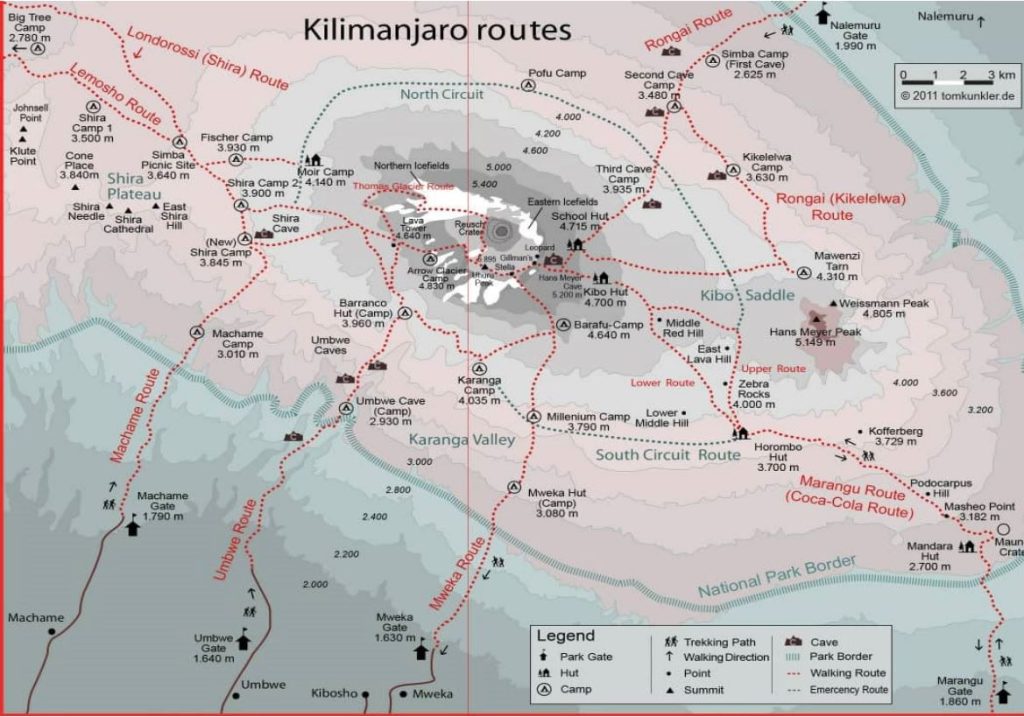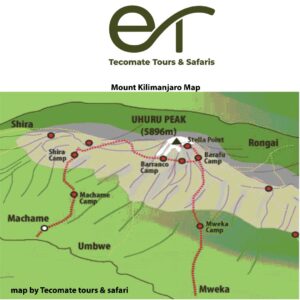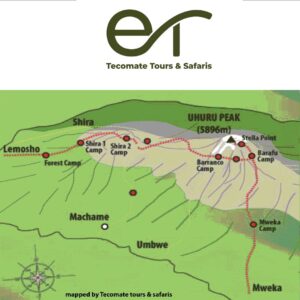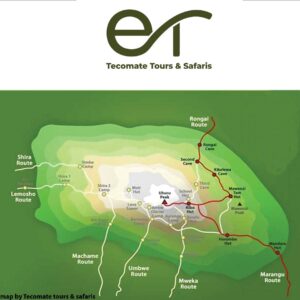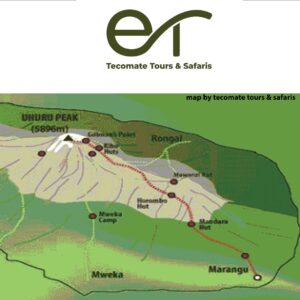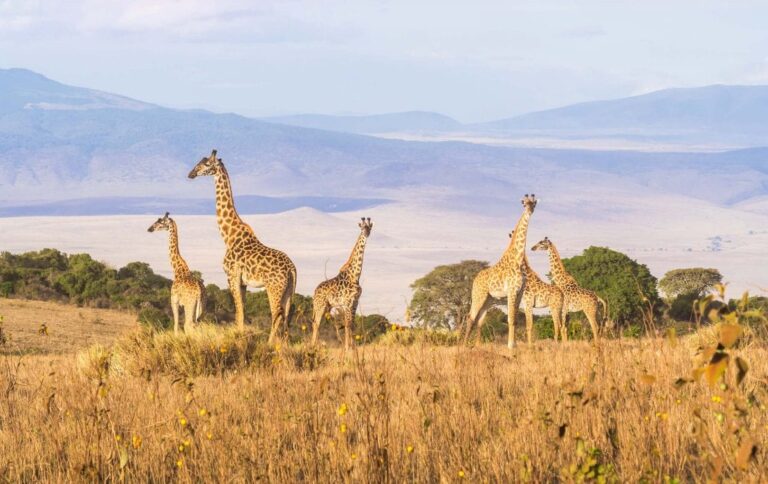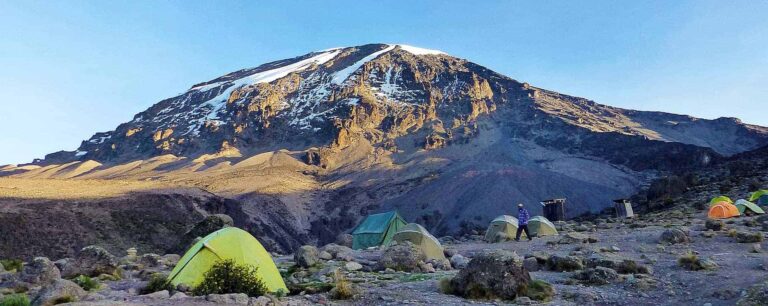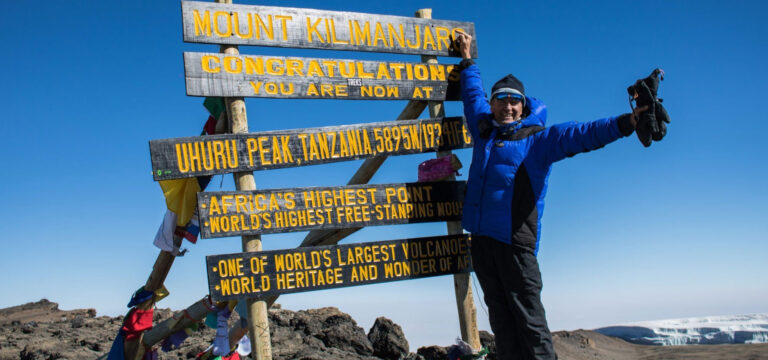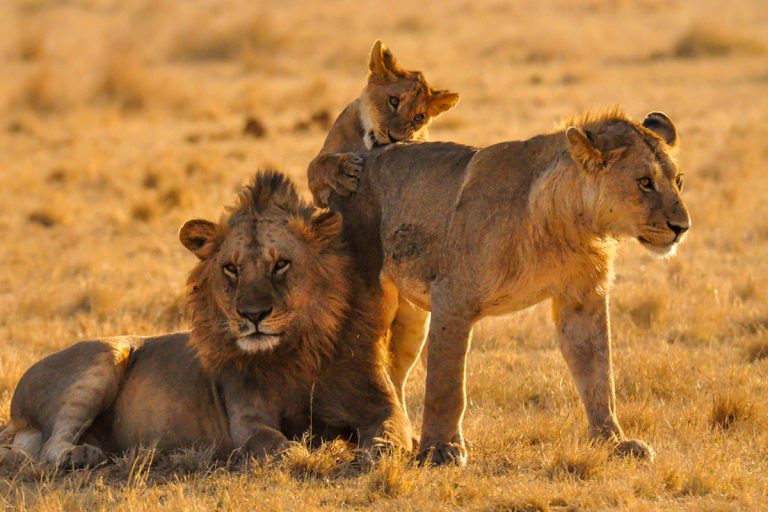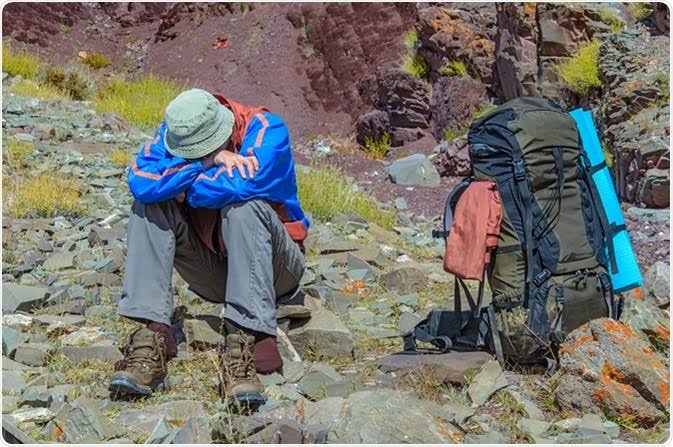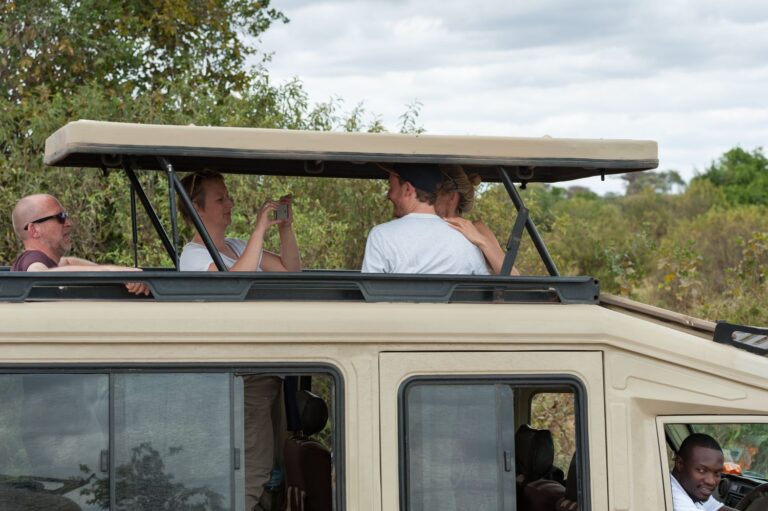Tecomate Tours and Safaris analyzed the best trekking route to take when planning your trekking tour to Mount Kilimanjaro. Not only is Mount Kilimanjaro affectionately known as Africa’s highest peak at 5895m, but it is also the highest free-standing mountain in the world.
To successfully climb Mount Kilimanjaro, many variables must be considered, and the most essential of which is selecting the optimal trekking route. Mount Kilimanjaro can be trekked from a variety of starting places permitted by the Tanzanian government through its National Park Parastatal (TANAPA). However, each route gets to the summit, but there are some differences in experience success rates, as mentioned in each route below.
.
The following are the authorized routes to trek Mount Kilimanjaro.
MACHAME ROUTE
The Machame route is known as a whiskey route and it is the most popular route up Mount Kilimanjaro. Depending on your fitness level, with this route, you will be trekking for 6-7 hours nearly every day at rising altitudes. You must be prepared to spend 12-15 hours on your feet to reach the peak. Climbing for 6-8 hours, then descending for 6-7 hours. Arriving in excellent physical and mental shape will be the key to your success!
Beginner climbers are sometimes concerned about how they will manage the Great Barranco Wall, but this is only a short scramble that isn’t all that difficult – you’ll be guided every step of the way by a skilled guide from Tecomate Tours and Safaris.
The Machame route is highly recommended for scenic value and has a high success rate (98%) particularly if the 7-day schedule is chosen. The six-day trek is not recommended for inexperienced hikers.
It is an excellent Kilimanjaro route for acclimatization because it offers hikers the opportunity to ascend high and sleep low on day 3 trekkers ascend from Shira Camp 2 to Lava Tower at 4,600 meters, where they eat before returning to Barranco Camp (3,900 meters) to sleep.
There is a strong chance to break the pre-summit day climb by adding an extra rest day at Karanga Camp (only available to seven-day trekkers) to allow hikers to be well-rested before summiting.
The route has been quite popular in recent years, which means it can get crowded, especially at Barranco, where climbers meet up with trekkers from the Lemosho, Shira, and Umbwe routes (see Barranco Wall for more information).
The Machame route alone provides fully catered camping facilities.
LEMOSHO ROUTE
The Lemosho route is a stunning path that begins on the western side of Mount Kilimanjaro. Because of its route profile, the Lemosho may be done in seven or eight days and provides ample possibilities for good acclimatization. It is one of the top
Kilimanjaro routes and has a high summit success rate due to its varied route profile.
Tecomate Tours also recommends it since the beginning location is rather secluded, giving trekkers a more pristine and untamed start to their Kilimanjaro trip. Seeing huge animals such as antelope, buffalo, and even elephants is unusual but not impossible.
The route also provides unparalleled and spectacular views of the dramatic gorges that characterize the western side of Mount Kilimanjaro. The Lemosho offers trekkers the experience of hiking across the Shira Plateau – one of the largest high-altitude plateaus in the world
On day 3, trekkers on the Lemosho route typically join the Machame route at Barranco camp and take the Barafu camp route to the summit; however, it is now quite common for Lemosho trekkers to veer north before Lava Tower to join the Northern Circuit route which circles the north side of Mount Kilimanjaro and follows the summit passage via Gilman’s Point.
Trekkers who wish to ascend via the Western Breach route can also take the Lemosho route instead. The Lemosho Route, like the Machame Route, includes a fully catered camping accommodation style and Tecomate Tours and Safari provide proper equipment for comfortable and successful trekking.
NORTHERN CIRCUIT ROUTE
The Northern Circuit route is the longest route on Mount Kilimanjaro and has one of the greatest summit success percentages because of the several high-altitude climbs, sleep-low and more time to acclimate.
The path begins at the same spot as Lemosho but then joins the Northern Circuit near Lava Tower before crossing Mount Kilimanjaro’s north slopes and reaching the summit via Gilman’s spot which is also a summiting path for those who take the Marangu route.
The course can be done in eight or nine days. If you want a calm and wild Kilimanjaro experience, this is the path for you.
RONGAI ROUTE
The Rongai route begins on the northeast edge of Kilimanjaro National Park, which is the sole northern starting point to Kilimanjaro Mountain.
In the early parts of the ascent, the Rongai route offers a true wilderness experience, and enormous wildlife such as buffalo, antelope, and elephants can be seen at the mountain base.
Because the northern slopes are dryer than the southern slopes, the Rongai is an excellent Kilimanjaro Route for hiking during the wet season. However, because the northern slopes are dryer, they may be less picturesque. Having said that, a northern approach is generally distinguished by good views of Kilimanjaro, which are uncommon from the southern side.
The Rongai is also a flatter path for the first few days, making it an easy journey. The route is typically done in seven days, but due to limited climb high, sleep low options, acclimatization prospects are not as good as on other Kilimanjaro routes.
The Rongai route typically follows the path from School Hut up via Hans Meyer Cave and Gilman’s Point to Uhuru Peak. The route descends through the Marangu path, thus camping is fully provisioned until the final night on the mountain – drinks at Horombo Hut.
MARANGU ROUTE.
The Marangu route is also referred to as the ‘Coca-Cola’ route. Marangu is the oldest route and is frequently chosen by unprepared beginner climbers due to its reputation as the “easiest” Kilimanjaro route, which is ascribed to the lower success rate.
It is also the shortest Kilimanjaro route with a rather poor acclimatization profile, which contributes significantly to the Marangu’s low success rates.
The six-day plan allows trekkers to climb high and sleep low; however, the elevation is moderate and not as effective as other climb-high, sleep-low options available on other Kilimanjaro itineraries.
The Marangu route is the only one on Kilimanjaro that offers dormitory-style lodging in huts for the entirety of the climb. The huts are equipped with mattresses and basic facilities, making them a popular choice for low-cost tour operators that lack the necessary equipment to climb the other Kilimanjaro routes.
The Marangu offers stunning views from the Saddle, but it is less spectacular than other Kilimanjaro routes owing to the ascent and descent on the same track.
WESTERN BREACH
The Western Breach is the technically hardest approach to Mount Kilimanjaro, but probably the most rewarding!. The Umbwe Route is commonly used to reach the Western Breach, which is then followed north and up from Lava Tower.
After a deadly rockfall in 2006, the Western Breach was closed and reopened in 2007 with a new and safer route design. Despite this, many tour operators do not include the Western Breach in their route list.
Only suggested for experienced trekkers – it is strongly required that all Western Breach climbers wear helmets, and it is not uncommon to require point crampons during the wet season when sub-surface ice can be a problem.
Because the path is normally only attempted by experienced high-altitude trekkers, success rates are often moderate to high.
SHIRA ROUTE
Shira Route begins at 3,600 meters above sea level, making it unsuitable for hikers with little or no expertise in high-altitude walking. The Shira Route and the Lemosho Route are nearly identical. Shira was the original route before Lemosho was developed to improve the route’s starting location. Whereas the Lemosho Route begins at the Londorossi Gates in the lush Kilimanjaro rainforest, the Shira Route starts further north and higher up at the Shira Gate.
On the first day hikers trek from Shira Gate to Simba Camp which is at a very similar altitude, allowing trekkers to acclimatise before joining the Lemosho Route on day two at Shira Camp 2. The high starting point is however a major negative for this route and some trekkers experience altitude sickness from day one as their bodies haven’t had enough time to acclimatise.
After Shira Camp 2, the path connects with the Machame path via Lava Tower before descending to Barranco Camp via the Southern Circuit. The ascent to Uhuru Peak, like the Machame, Umbwe, and Lemosho Routes, begins in Barafu Camp and proceeds up the southern slopes of Kibo. The descent is via the Mweka Route.
Tecomate Tours and Safaris advises against taking the Shira route for two reasons. For starters, the starting elevation of 3,600 meters means you won’t have much time to acclimate and the likelihood of experiencing altitude sickness symptoms is extremely significant. Second, the Shira route avoids the beautiful rainforest on Kilimanjaro’s western slope, instead beginning in a barren and uninteresting area”.
Tecomate Tours and Safaris gives the best guides that are knowledgeable about all of the processes and have the requisite guidance abilities for successful trekking on whichever route you take. Contact us right away for expert advice on which route to take and when to travel for Mount Kilimanjaro trekking.

